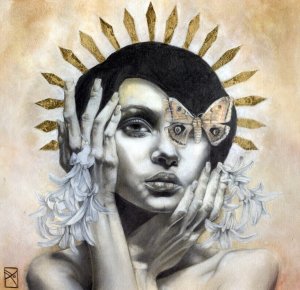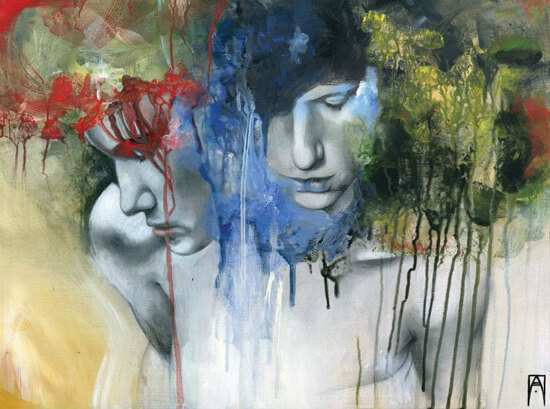Anxiety and Its Many Forms

Anxiety is one of the most unpleasant sensations that people can experience. The level of discomfort depends on the intensity of the sensation and the context in which it appears.
Generally, anxiety interferes with the person’s daily life, though sometimes it’s impossible for the person to do the things they need to do normally during the day.
In this article, we will try to explain the basic aspects of anxiety, and if you identify with any of them, it might be a good idea to seek professional help from a clinical psychologist who specializes in this area.
What is it?
Anxiety disorders are the most common psychological disorders among the general population. Since it’s a very broad term, it’s good to know how to differentiate between the different ways it manifests itself. To do so, we explain the difference between panic, fear, and phobias below.
Anxiety is an emotional reaction that involves feelings of stress, apprehension, nervousness, and worry that activate the autonomic nervous system. Panic is the same sensation, but with predominant physical symptoms, while psychological symptoms predominate in anxiety.
While fears are associated with identifiable external stimuli, anxiety appears without a recognizable external threat. Phobias are disproportionate fears that typically result in irrationally avoidant behaviors.
Anxiety is anticipatory, which makes it a very uncomfortable and invasive feeling. It’s cognitive in nature and it’s oriented towards the future, which means it can appear at any moment.
Apart from the person’s own cognitive nature, there’s an element of learning that is conducive to its appearance. In addition, there’s a biological component; hyperactivity in the locus coeruleus, an imbalance in the neurotransmitter GABA, and differences in the neuronal network between the thalamus and the amygdala have all been observed in people who have it.

How does it work?
Anxiety is not a unified system, but rather it’s formed by a triple system response: the subjective system, the physiological system, and the motor system. They can occur all at once, or each can occur independently.
People usually experience unpleasant thoughts (subjective system), which they also feel in their body in the form of an irregular heart rate, dilation of the pupils, and shaking (physiological system). They also feel it in their facial expression, gestures, and manners of avoidance (motor system).
The symptoms of anxiety
Anxiety is fundamentally characterized by two common predominant sensations in the people who suffer it:
- Helplessness: feeling a lack of control, like you can’t do anything to avoid imminent, unpleasant internal and external events.
- Uncertainty: feeling like you don’t know what will happen in the future, which is disconcerting and causes distress and psychological unrest.
It has many symptoms in common with depression, but there’s also a great variety of other symptoms that differentiate the two. Some of the most common symptoms that it shares with depression are characterized by a high negative affect. These include worry, low concentration, irritability, insomnia, fatigue, psychomotor agitation, crying, feelings of inferiority, guilt, and low self-esteem.
The symptoms that are more specific to anxiety are fear, panic, nervousness, avoidance, instability, hypervigilance, perception of a threat or danger, high sympathetic nervous system activity, etc.
Within the umbrella of anxiety, there are many different syndromes that depend on the organization of symptoms. These include things like agoraphobia, panic attacks, specific phobias, social phobia, generalized anxiety disorder, and selective mutism.

Treatments
There are many possible treatments depending on the kind of anxiety disorder that you have, but some have shown to be more effective than others. It all depends on the specialist you see and which treatment will best help you.
For generalized anxiety disorder, the most common treatment is Cognitive Behavioral Therapy (CBT), which includes relaxation, cognitive therapy, exposure, and relapse prevention. Medication is also an effective treatment, while hypnosis is in the experimental phase.
For other common disorders like specific phobias, the treatment of choice is exposure. For social phobia, the treatment of choice is CBT along with Cognitive Restructuring (CR) and Social Skills Training (SST).
To confront your anxiety, first you have to get to know it, know yourself, and look for a good professional who can help you control it, as there are many different treatments that can be adjusted to fit the person and the type of anxiety. If it’s treated properly, there shouldn’t be much resistance to treatment.
Images courtesy of Patricia Ariel
Anxiety is one of the most unpleasant sensations that people can experience. The level of discomfort depends on the intensity of the sensation and the context in which it appears.
Generally, anxiety interferes with the person’s daily life, though sometimes it’s impossible for the person to do the things they need to do normally during the day.
In this article, we will try to explain the basic aspects of anxiety, and if you identify with any of them, it might be a good idea to seek professional help from a clinical psychologist who specializes in this area.
What is it?
Anxiety disorders are the most common psychological disorders among the general population. Since it’s a very broad term, it’s good to know how to differentiate between the different ways it manifests itself. To do so, we explain the difference between panic, fear, and phobias below.
Anxiety is an emotional reaction that involves feelings of stress, apprehension, nervousness, and worry that activate the autonomic nervous system. Panic is the same sensation, but with predominant physical symptoms, while psychological symptoms predominate in anxiety.
While fears are associated with identifiable external stimuli, anxiety appears without a recognizable external threat. Phobias are disproportionate fears that typically result in irrationally avoidant behaviors.
Anxiety is anticipatory, which makes it a very uncomfortable and invasive feeling. It’s cognitive in nature and it’s oriented towards the future, which means it can appear at any moment.
Apart from the person’s own cognitive nature, there’s an element of learning that is conducive to its appearance. In addition, there’s a biological component; hyperactivity in the locus coeruleus, an imbalance in the neurotransmitter GABA, and differences in the neuronal network between the thalamus and the amygdala have all been observed in people who have it.

How does it work?
Anxiety is not a unified system, but rather it’s formed by a triple system response: the subjective system, the physiological system, and the motor system. They can occur all at once, or each can occur independently.
People usually experience unpleasant thoughts (subjective system), which they also feel in their body in the form of an irregular heart rate, dilation of the pupils, and shaking (physiological system). They also feel it in their facial expression, gestures, and manners of avoidance (motor system).
The symptoms of anxiety
Anxiety is fundamentally characterized by two common predominant sensations in the people who suffer it:
- Helplessness: feeling a lack of control, like you can’t do anything to avoid imminent, unpleasant internal and external events.
- Uncertainty: feeling like you don’t know what will happen in the future, which is disconcerting and causes distress and psychological unrest.
It has many symptoms in common with depression, but there’s also a great variety of other symptoms that differentiate the two. Some of the most common symptoms that it shares with depression are characterized by a high negative affect. These include worry, low concentration, irritability, insomnia, fatigue, psychomotor agitation, crying, feelings of inferiority, guilt, and low self-esteem.
The symptoms that are more specific to anxiety are fear, panic, nervousness, avoidance, instability, hypervigilance, perception of a threat or danger, high sympathetic nervous system activity, etc.
Within the umbrella of anxiety, there are many different syndromes that depend on the organization of symptoms. These include things like agoraphobia, panic attacks, specific phobias, social phobia, generalized anxiety disorder, and selective mutism.

Treatments
There are many possible treatments depending on the kind of anxiety disorder that you have, but some have shown to be more effective than others. It all depends on the specialist you see and which treatment will best help you.
For generalized anxiety disorder, the most common treatment is Cognitive Behavioral Therapy (CBT), which includes relaxation, cognitive therapy, exposure, and relapse prevention. Medication is also an effective treatment, while hypnosis is in the experimental phase.
For other common disorders like specific phobias, the treatment of choice is exposure. For social phobia, the treatment of choice is CBT along with Cognitive Restructuring (CR) and Social Skills Training (SST).
To confront your anxiety, first you have to get to know it, know yourself, and look for a good professional who can help you control it, as there are many different treatments that can be adjusted to fit the person and the type of anxiety. If it’s treated properly, there shouldn’t be much resistance to treatment.
Images courtesy of Patricia Ariel
This text is provided for informational purposes only and does not replace consultation with a professional. If in doubt, consult your specialist.







